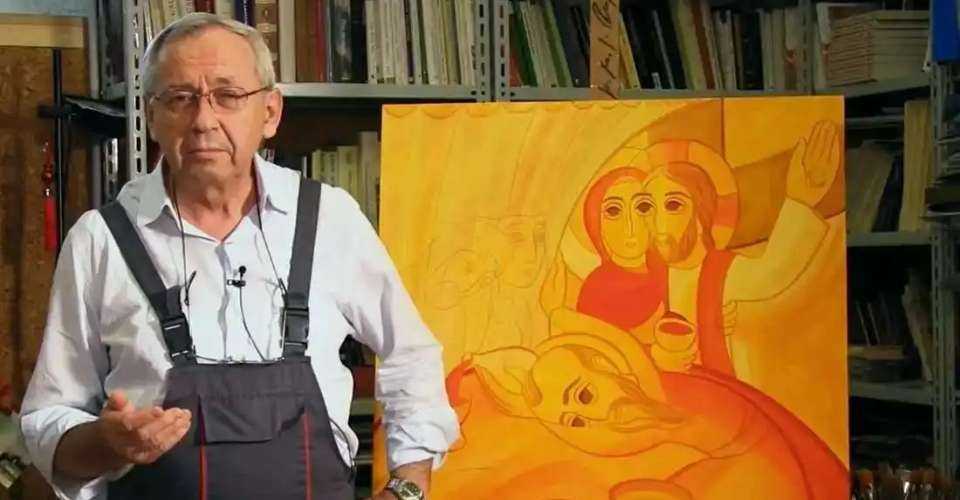
A screengrab of Father Rupnik explaining the image of the 2022 World Meeting of Families. (Photo: Diocese of Rome / YouTube)
On the final day of the Catholic Media Conference in Atlanta, the prefect of the Vatican's Dicastery for Communication addressed questions posed by journalists about the dicastery's regular practice of posting art by Father Marko Rupnik -- a Rome-based priest accused of sexually abusing multiple women -- on the Vatican News website and social media, especially to illustrate church feast days.
"As Christian(s), we are asked not to judge," Paolo Ruffini said to a room full of communications professionals after giving an address at the CMC June 21. He explained that while the process of a Vatican investigation into Father Rupnik is still ongoing, "an anticipation of a decision is something that is not, in our opinion, is not good."
"There are things we don't understand," he said. Ruffini also added they "did not put in any new photos" of Father Rupnik's art, but rather have been using what they had. "We didn't decide what was not on our charge to decide," he said.
In December 2022, Rome's Jesuit headquarters disclosed it had suspended the Rome-based priest and famous mosaic artist from membership after sexual abuse claims, but Jesuit officials said the claims had been dismissed by the Vatican's Dicastery for the Doctrine of the Faith because of the church's 20-year statute of limitations.
In June 2023, the order said it had expelled Father Rupnik for disobedience after it compiled a 150-page dossier of credible accusations against him, believed to involve between 20 to 40 women.
However, on Oct. 27, 2023, Pope Francis waived the statute of limitations and instructed the doctrinal dicastery to initiate a new investigation after the Pontifical Commission for the Protection of Minors had highlighted "serious problems" in handling his case.
Mentioning "civilization," and "humanity along the centuries," Ruffini spoke directly to the question some have put forward about removing or destroying Father Rupnik's art.
"Removing, deleting, destroying art has not ever been a good choice," Ruffini said, mentioning legendary Italian artist Michelangelo Merisi da Caravaggio, known widely as simply Caravaggio, who in the course of his life killed a man.
Removing Father Rupnik's art from public space "is not a Christian response," Ruffini said.
Responding to the question first posed by Colleen Dulle of the Jesuit-published America Magazine, Ruffini mentioned that the Jesuit curia in Rome did not remove Father Rupnik's art from their chapel.
"I think this is also something that can be inspiring in terms of being Christian," Ruffini said, encouraging patience toward the decision of the Vatican bodies investigating the case.
In a follow-up question, OSV News asked Ruffini how communion through communications, which the prefect mentioned in his address to the journalists gathered there, corresponds to the communion with victims of abuse regarding the posting of Father Rupnik's images to the Vatican News website, and what he would like to say specifically to victims regarding his comments.
"The closeness of the church to any victims is clear," Ruffini replied.
He added, "But it's clear also that there is a procedure going on. So we have to wait (for) the procedure."
"We are not talking about abuse of minors," Ruffini said. "We are talking (about) a story that we don't know."
"And I think that as Christians, we have to understand that the closeness to the victims is important. But I don't know that this is the way of healing," Ruffini added, saying that "there are people that (are) praying in sanctuaries of many churches all around the world" in front of mosaics created by Father Rupnik.
"I don't think we have to throw stones thinking that this is the way of healing," he said.
"Do you think that if I put away a photo of an art (away) from ... our website, I will be more close to the victims? Do you think so?" he pressed journalists at the end of his answer. When an answer was given in the affirmative, Ruffini responded: "I think you're wrong."
Born at Zadlog, Slovenia, Father Rupnik was ordained in 1985 and became famous for his large-scale mosaics, which are displayed at over 200 Catholic centers worldwide, including the Vatican's Redemptoris Mater Chapel and the St. John Paul II National Shrine in Washington.
After accusations of spiritual and sexual abuse from dozens of women, including former sisters of the Loyola Community, the calls for the removal of the priest's artworks have since come from advocacy groups.
The alleged victims of Father Rupnik told OSV News in April that his art cannot be separated from abuse claims.
The close link between Father Rupnik's artistic work and the abuses he allegedly committed was confirmed to OSV News by Gloria Branciani, a former religious of the Loyola Community in Slovenia who alleged Father Rupnik abused her for nine years when the Jesuit was the spiritual director of the Loyola Community.
"In Rupnik, the sexual dimension cannot be separated from the creative experience," Branciani told OSV News, when asked about his artistic projects. "In portraying me, he explained that I represented the eternal feminine: His artistic inspiration stems precisely from his approach to sexuality," she explained.
On Feb. 21, Vatican News reported the Vatican Dicastery for the Doctrine of the Faith "has contacted several institutions over the past months to obtain documentation related to Father Marko Rupnik," and that the Holy See Press Office confirmed that the dicastery's investigation was "expanded into other ecclesial realities with which there had previously been no contact."


